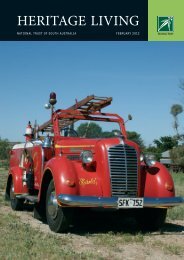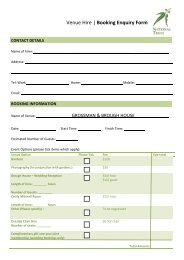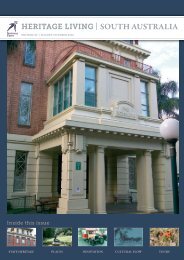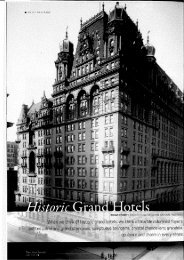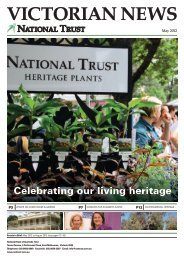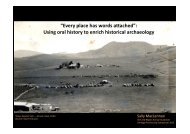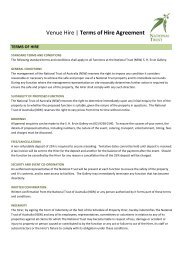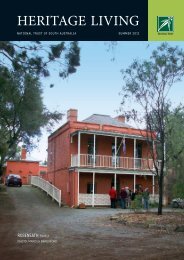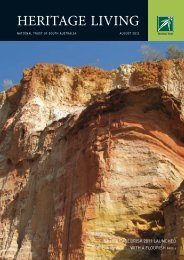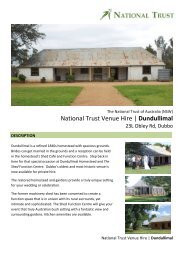Trust News Article The Great Barrier Reef â A cultural perspective by
Trust News Article The Great Barrier Reef â A cultural perspective by
Trust News Article The Great Barrier Reef â A cultural perspective by
Create successful ePaper yourself
Turn your PDF publications into a flip-book with our unique Google optimized e-Paper software.
<strong>The</strong> <strong>Great</strong> <strong>Barrier</strong> <strong>Reef</strong> – A <strong>cultural</strong> <strong>perspective</strong>Peter Dowling<strong>Trust</strong> <strong>News</strong> Vol 6 No 2 2013Sunday October 10 th 1802I found the reef upon which we landed to be a body of dead coral of various kinds thatappeared to have been washed up gradually to a bank … <strong>The</strong> deeper water round theedges of the dry bank shewed corals of various forms, sizes colours and constructions,and we could not but admi[re] the beauty of the scene although so pregnant withdestruction to seamen. (Matthew Flinders ‐ Journal on HMS 'Investigator', vol.2, 1802‐1803)When considering the <strong>Great</strong> <strong>Barrier</strong> <strong>Reef</strong> lying off the northeast coast ofAustralia, most conjure up images of opaline waters, colourful coral bodies withvibrant, gaudy fish slowly swimming about. Others may think about the starkwastelands of dying coral that are ever increasing. Indeed, most perceptions ofthe <strong>Reef</strong> are about the associations of flora and fauna with the natural habitats ina unique and extraordinary environment. To that regard the <strong>Reef</strong> was inscribedon the World Heritage List in 1981 primarily for its outstanding natural values.But there is more to the <strong>Reef</strong> than these perceptions.<strong>The</strong> development of the <strong>Great</strong> <strong>Barrier</strong> <strong>Reef</strong> began 15,000 years ago as the postIce Age sea levels along the northeast continental shelf began to rise as a result ofglobal warming. By 6,000 years ago the coast stabilised to the present levels.<strong>The</strong> upward growth of coral bodies began to develop during this period of risingseas forming the structural architecture of the <strong>Great</strong> <strong>Barrier</strong> <strong>Reef</strong>.<strong>The</strong> <strong>Reef</strong> stretches for some 2,300 kilometres along the Queensland coast fromCape York in the north to about 100 kilometres south of Gladstone andencompasses 348,000 square kilometres of marine habitat. <strong>The</strong>re are around3,000 separate coral reefs, 600 continental islands and 300 coral and sand cayswithin that area.Archaeological research has shown that Indigenous groups have used the reefand many of its islands since at least 8,500 years ago, prior to present sea levelstabilisation. <strong>The</strong> archaeology has revealed that at first the visits to the islandswere sporadic and seasonal but began to increase 2,000 years ago. Permanentand semi‐permanent settlement occurred on a number of islands includingHinchinbrook, Dunk, the Whitsundays and the Kepples. <strong>The</strong> most distant islands,which revealed occupation sites, are the Percy Islands, 85 kilometres from themainland – a substantial voyage for a canoe. On Hinchinbrook Island they builtextensive and permanent stone fish and mollusc traps to ensure a constant andreliable source of food. <strong>The</strong> Yintayin rock shelter on Stanley Island, in theFlinders Group, displays spectacular painted images relating to Indigenous
Rounding Cape York on 22 August Cook hoisted the British colours at PossessionIsland and is so doing, claimed the east coast of the continent for Britain. Cooklater suggested it should be named New South Wales.Others were not so fortunate as Cook and the Endeavour. In 1791 the 24‐gunfrigate, HMS Pandora, was wrecked on the <strong>Reef</strong>. <strong>The</strong> Pandora, with CaptainEdwards in command, had been sent from Britain to find, capture and returnwith the mutineers from the Bounty, an enormous task given the distances thathad to be travelled. <strong>The</strong> ship searched the South Pacific for almost four monthscapturing fourteen mutineers. <strong>The</strong>y were confined in a specially built structureon the quarterdeck of the Pandora, know as Pandora’s Box. Sailing north withinthe <strong>Great</strong> <strong>Barrier</strong> <strong>Reef</strong> the ship ran aground sustaining serious damage to thehull.<strong>The</strong> hands were immediately turned to the pumps, and to bale at thedifferent hatchways. Some of the prisoners were let out of irons, andturned to the pumps. At this dreadful crisis, it blew very violently; and shebeat so hard upon the rocks, that we expected her, every minute, to go topieces. It was an exceeding dark, stormy night; and the gloomy horrors ofdeath presented us all round, being every where encompassed with rocks,shoals, and broken water. … (Surgeon George Hamilton, HMS Pandora)<strong>The</strong> ship overturned and sank. Thirty‐one of the crew and four mutineers werelost. <strong>The</strong> remainder, eighty‐nine crew and ten mutineers, spent two nights on asand cay and with some of Pandora’s boats recovered, spent eighteen, thirsty andscorching hot days at sea before making Timor and final safety with the Dutch atKupang. <strong>The</strong> mutineers finally reached Britain in June 1792 to face trial.<strong>The</strong>re are about thirty other shipwrecks of historic importance within the <strong>Great</strong><strong>Barrier</strong> <strong>Reef</strong>. One of the most well known is the Yongala, a coastal steamer thatsank during a cyclone in March 1911 with the loss of 122 passengers and crew.It is now one of Australia’s most popular wreck dives and site of nationalsignificance supporting a great diversity of fish life with over a hundred recordedspecies in an established community.Perhaps it is now time for a re‐evaluation of the heritage values of the reef andan assertion of its historical and <strong>cultural</strong> values.ReferencesFlinders, Matthew, Journal of HMS Investigator, vol2. 1802‐1803http://acms.sl.nsw.gov.au/item/itemdetailpaged.aspx?itemid=210413Hamilton, George, A Voyage Around the World,http://www.fatefulvoyage.com/pandora/pandoraIHamilton01.htmlUNESCO World Heritage List, <strong>Great</strong> <strong>Barrier</strong> <strong>Reef</strong>, Australiahttp://whc.unesco.org/en/list/154



